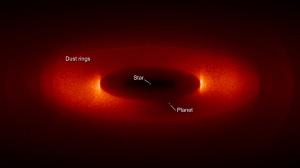Supercomputer simulations of dusty disks around sunlike stars show that planets nearly as small as Mars can create patterns that future telescopes may be able to detect. The research points to a new avenue in the search for habitable planets.
"It may be a while before we can directly image earthlike planets around other stars but, before then, we'll be able to detect the ornate and beautiful rings they carve in interplanetary dust," says Christopher Stark, the study's lead researcher at the University of Maryland, College Park.

© NASA/Christopher Stark, GSFCA planet twice Earth's mass forms a ringed dust structure in this simulation. Enhanced dust density leads and trails the planet and causes periodic brightenings.
Working with Marc Kuchner at NASA's Goddard Space Flight Center in Greenbelt, Md., Stark modeled how 25,000 dust particles responded to the presence of a single planet -- ranging from the mass of Mars to five times Earth's -- orbiting a sunlike star. Using NASA's Thunderhead supercomputer at Goddard, the scientists ran 120 different simulations that varied the size of the dust particles and the planet's mass and orbital distance.
